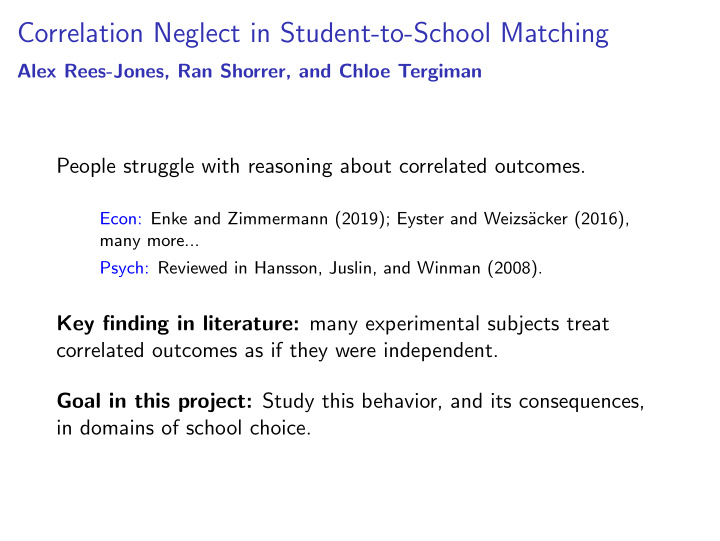



Correlation Neglect in Student-to-School Matching Alex Rees-Jones, Ran Shorrer, and Chloe Tergiman People struggle with reasoning about correlated outcomes. Econ: Enke and Zimmermann (2019); Eyster and Weizs¨ acker (2016), many more... Psych: Reviewed in Hansson, Juslin, and Winman (2008). Key finding in literature: many experimental subjects treat correlated outcomes as if they were independent. Goal in this project: Study this behavior, and its consequences, in domains of school choice.
A simple example with correlated admissions There are three schools to consider. You can apply to two. Admissions based on a single, random priority number. ◮ Drawn from Uniform[0,100]. School Utility Admission Requirement The good one (A) 3 50 The middle one (B) 2 45 The bad one (C) 1 0 A ≻ B Aggressive Strategy → ( A B , 5%; ∅ ∅ ∅ , 45%) A A , 50%; B B A ≻ C Diversified Strategy → ( A A A , 50%; C C C , 50%)
A simple example with uncorrelated admissions There are three schools to consider. You can apply to two. Admissions based on school-specific, random priority numbers. ◮ Each independently drawn from Uniform[0,100]. School Utility Admission Requirement The good one (A) 3 50 The middle one (B) 2 90 The bad one (C) 1 0 A ≻ B Aggressive Strategy → ( A B , 5%; ∅ ∅ ∅ , 45%) A A , 50%; B B A ≻ C Diversified Strategy → ( A A A , 50%; C C C , 50%)
This project We conduct a lab experiment with incentivized pairs of scenarios like the one already considered. Findings: ◮ Within “matched pair” scenarios, choices vary depending on experimentally manipulated presence or absence of correlation. ◮ With correlated admissions, “safety” options neglected. ◮ Both within-subject and between-subjects. ◮ Choices in the presence of correlation are suspect. 1. Analytically unwise. 2. Patterns match our theoretical prediction on correlation-neglectful agents 3. Inconsistent with transparent choice. 4. Within-subject preference reversals predicted by Enke-Zimmermann measure of correlation neglect.
Recommend
More recommend